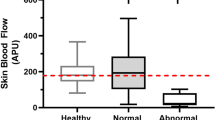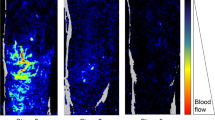Abstract
Background
During septic shock management, the evaluation of microvascular perfusion by skin analysis is of interest. We aimed to study the skin capillary refill time (CRT) in a selected septic shock population.
Methods
We conducted a prospective observational study in a tertiary teaching hospital. After a preliminary study to calculate CRT reproducibility, all consecutive patients with septic shock during a 10-month period were included. After initial resuscitation at 6 h (H6), we recorded hemodynamic parameters and analyzed their predictive value on 14-day mortality. CRT was measured on the index finger tip and on the knee area.
Results
CRT was highly reproducible with an excellent inter-rater concordance calculated at 80 % [73–86] for index CRT and 95 % [93–98] for knee CRT. A total of 59 patients were included, SOFA score was 10 [7–14], SAPS II was 61 [50–78] and 14-day mortality rate was 36 %. CRT measured at both sites was significantly higher in non-survivors compared to survivors (respectively 5.6 ± 3.5 vs 2.3 ± 1.8 s, P < 0.0001 for index CRT and 7.6 ± 4.6 vs 2.9 ± 1.7 s, P < 0.0001 for knee CRT). The CRT at H6 was strongly predictive of 14-day mortality as the area under the curve was 84 % [75–94] for the index measurement and was 90 % [83–98] for the knee area. A threshold of index CRT at 2.4 s predicted 14-day outcome with a sensitivity of 82 % (95 % CI [60–95]) and a specificity of 73 % (95 % CI [56–86]). A threshold of knee CRT at 4.9 s predicted 14-day outcome with a sensitivity of 82 % (95 % CI [60–95]) and a specificity of 84 % (95 % CI [68–94]). CRT was significantly related to tissue perfusion parameters such as arterial lactate level and SOFA score. Finally, CRT changes during shock resuscitation were significantly associated with prognosis.
Conclusion
CRT is a clinical reproducible parameter when measured on the index finger tip or the knee area. After initial resuscitation of septic shock, CRT is a strong predictive factor of 14-day mortality.



Similar content being viewed by others
References
Ince C (2005) The microcirculation is the motor of sepsis. Crit Care 9(Suppl 4):S13–S19
Dellinger RP, Levy MM, Rhodes A, Annane D, Gerlach H, Opal SM, Sevransky JE, Sprung CL, Douglas IS, Jaeschke R, Osborn TM, Nunnally ME, Townsend SR, Reinhart K, Kleinpell RM, Angus DC, Deutschman CS, Machado FR, Rubenfeld GD, Webb S, Beale RJ, Vincent JL, Moreno R, Surviving Sepsis Campaign Guidelines Committee including the Pediatric Subgroup (2013) Surviving sepsis campaign: international guidelines for management of severe sepsis and septic shock, 2012. Intensive Care Med 39(2):165–228. doi:10.1007/s00134-012-2769-8
Ait-Oufella H, Maury E, Lehoux S, Guidet B, Offenstadt G (2010) The endothelium: physiological functions and role in microcirculatory failure during severe sepsis. Intensive Care Med 36(8):1286–1298. doi:10.1007/s00134-010-1893-6
De Backer D, Donadello K, Sakr Y, Ospina-Tascon G, Salgado D, Scolletta S, Vincent JL (2013) Microcirculatory alterations in patients with severe sepsis: impact of time of assessment and relationship with outcome. Crit Care Med 41(3):791–799. doi:10.1097/CCM.0b013e3182742e8b
De Backer D, Ospina-Tascon G, Salgado D, Favory R, Creteur J, Vincent JL (2010) Monitoring the microcirculation in the critically ill patient: current methods and future approaches. Intensive Care Med 36(11):1813–1825. doi:10.1007/s00134-010-2005-3
De Backer D, Hollenberg S, Boerma C, Goedhart P, Buchele G, Ospina-Tascon G, Dobbe I, Ince C (2007) How to evaluate the microcirculation: report of a round table conference. Crit Care 11(5):R101. doi:10.1186/cc6118
Vic-Dupont V, Coulaud JP, Carbon C (1968) Le choc au cours des infections (signes et étiologies). Les journées de réanimation de l’Hôpital Claude Bernard, Libraries Arnette edn., Paris
Altemeier WA, Cole W (1956) Septic shock. Ann Surg 143(5):600–607
Joly HR, Weil MH (1969) Temperature of the great toe as an indication of the severity of shock. Circulation 39(1):131–138
Ait-Oufella H, Lemoinne S, Boelle PY, Galbois A, Baudel JL, Lemant J, Joffre J, Margetis D, Guidet B, Maury E, Offenstadt G (2011) Mottling score predicts survival in septic shock. Intensive Care Med 37(5):801–807. doi:10.1007/s00134-011-2163-y
Gove S, Tamburlini G, Molyneux E, Whitesell P, Campbell H (1999) Development and technical basis of simplified guidelines for emergency triage assessment and treatment in developing countries. WHO integrated management of childhood illness (IMCI) referral care project. Arch Dis Child 81(6):473–477
Evans JA, May J, Ansong D, Antwi S, Asafo-Adjei E, Nguah SB, Osei-Kwakye K, Akoto AO, Ofori AO, Sambian D, Sylverken J, Busch W, Timmann C, Agbenyega T, Horstmann RD (2006) Capillary refill time as an independent prognostic indicator in severe and complicated malaria. J Pediatr 149(5):676–681. doi:10.1016/j.jpeds.2006.07.040
Tibby SM, Hatherill M, Murdoch IA (1999) Capillary refill and core-peripheral temperature gap as indicators of haemodynamic status in paediatric intensive care patients. Arch Dis Child 80(2):163–166
Lima A, Jansen TC, van Bommel J, Ince C, Bakker J (2009) The prognostic value of the subjective assessment of peripheral perfusion in critically ill patients. Crit Care Med 37(3):934–938. doi:10.1097/CCM.0b013e31819869db
Hernandez G, Pedreros C, Veas E, Bruhn A, Romero C, Rovegno M, Neira R, Bravo S, Castro R, Kattan E, Ince C (2012) Evolution of peripheral vs metabolic perfusion parameters during septic shock resuscitation. A clinical-physiologic study. J Crit Care 27(3):283–288. doi:10.1016/j.jcrc.2011.05.024
Levy MM, Fink MP, Marshall JC, Abraham E, Angus D, Cook D, Cohen J, Opal SM, Vincent JL, Ramsay G (2003) 2001 SCCM/ESICM/ACCP/ATS/SIS international sepsis definitions conference. Crit Care Med 31(4):1250–1256. doi:10.1097/01.CCM.0000050454.01978.3B
Moreno R, Vincent JL, Matos R, Mendonca A, Cantraine F, Thijs L, Takala J, Sprung C, Antonelli M, Bruining H, Willatts S (1999) The use of maximum SOFA score to quantify organ dysfunction/failure in intensive care. Results of a prospective, multicentre study. Working Group on Sepsis related Problems of the ESICM. Intensive Care Med 25(7):686–696
Le Gall JR, Lemeshow S, Saulnier F (1993) A new simplified acute physiology score (SAPS II) based on a European/North American multicenter study. JAMA 270(24):2957–2963
Shrout PE, Fleiss JL (1979) Intraclass correlations: uses in assessing rater reliability. Psychol Bull 86(2):420–428
Euser AM, Dekker FW, le Cessie S (2008) A practical approach to Bland-Altman plots and variation coefficients for log transformed variables. J Clin Epidemiol 61(10):978–982. doi:10.1016/j.jclinepi.2007.11.003
Ait-Oufella H, Bourcier S, Alves M, Galbois A, Baudel JL, Margetis D, Bige N, Offenstadt G, Maury E, Guidet B (2013) Alteration of skin perfusion in mottling area during septic shock. Ann Intensive Care 3(1):31. doi:10.1186/2110-5820-3-31
Ait-Oufella H, Joffre J, Boelle PY, Galbois A, Bourcier S, Baudel JL, Margetis D, Alves M, Offenstadt G, Guidet B, Maury E (2012) Knee area tissue oxygen saturation is predictive of 14-day mortality in septic shock. Intensive Care Med 38(6):976–983. doi:10.1007/s00134-012-2555-7
Oppert M, Engel C, Brunkhorst FM, Bogatsch H, Reinhart K, Frei U, Eckardt KU, Loeffler M, John S (2008) Acute renal failure in patients with severe sepsis and septic shock–a significant independent risk factor for mortality: results from the German prevalence study. Nephrol Dial Transplant 23(3):904–909. doi:10.1093/ndt/gfm610
Mikkelsen ME, Miltiades AN, Gaieski DF, Goyal M, Fuchs BD, Shah CV, Bellamy SL, Christie JD (2009) Serum lactate is associated with mortality in severe sepsis independent of organ failure and shock. Crit Care Med 37(5):1670–1677. doi:10.1097/CCM.0b013e31819fcf68
Kim YA, Ha EJ, Jhang WK, Park SJ (2013) Early blood lactate area as a prognostic marker in pediatric septic shock. Intensive Care Med 39(10):1818–1823. doi:10.1007/s00134-013-2959-z
Schriger DL, Baraff LJ (1991) Capillary refill–is it a useful predictor of hypovolemic states? Ann Emerg Med 20(6):601–605 S0196-0644(05)82375-3
Sakr Y, Dubois MJ, De Backer D, Creteur J, Vincent JL (2004) Persistent microcirculatory alterations are associated with organ failure and death in patients with septic shock. Crit Care Med 32(9):1825–1831
Conflicts of interest
The authors had no conflict of interest.
Author information
Authors and Affiliations
Corresponding author
Additional information
Take-home message: Capillary refill time is a clinical reproducible parameter when measured on the index tip and the knee area. After initial resuscitation of septic shock, capillary refill time is a strong predictive factor of 14-day mortality.
Electronic supplementary material
Below is the link to the electronic supplementary material.
Rights and permissions
About this article
Cite this article
Ait-Oufella, H., Bige, N., Boelle, P.Y. et al. Capillary refill time exploration during septic shock. Intensive Care Med 40, 958–964 (2014). https://doi.org/10.1007/s00134-014-3326-4
Received:
Accepted:
Published:
Issue Date:
DOI: https://doi.org/10.1007/s00134-014-3326-4




